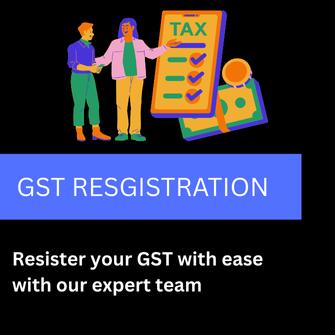
GST Registration
Completely managed GST registration service until obtaining GSTIN with Expert Support
About this item
- Filing of Application for GST Registration
- Secure GST Identification Number
- Dedicated manager to process your GST registration end to end
- Completely Online – No need to visit office
- CA Assisted GST Filing for all your GST needs
Documents Required for GST Registration
| Sole proprietor / Individual |
|
| LLP and Partnership Firms |
|
| HUF |
|
| Company (Public and Private) (Indian and foreign) |
|
Electricity Bill
Latest electricity bill for the premises where GST registration is applied for.
Telephone Bill
Latest telephone bill for the premises where GST registration is applied for in some states.
Property Tax Receipt
Latest property tax receipt for the premises where GST registration is applied for.
Lease / Rent Agreement
If the property is rented or leased, lease or rental agreement is required.
Passport Size Photo
Passport size photo of the authorised signatory under GST.
Partnership Deed
If applicant is a Partnership Firm, Partnership Deed must be submitted.
Incorporation Certificate
If applicant is a Company or LLP, Partnership Deed must be submitted.
PAN Card
PAN card of the authorised signatory under GST.
Aadhaar Card
Aadhaar card of the authorised signatory under GST.
Consent Letter
If the property is taken by a person without rental agreement.
The following are some of the advantages of GST registration:
Bank Loans: GST registration and GST return filing serve as proof of business activity and create track record for a business. Banks and NBFCs lend to businesses based on GST return data. Hence, GST registration can help you formalize your business and get credit.
Supplier Onboarding: To become a supplier of reputed companies, GST registration is often times a must during the supplier onboarding process. Hence, GST registration can help you get more business.
eCommerce: GST registration is a must to sell online and through various platforms like Amazon, Flipkart, Snapdeal, Zomato, Swiggy, etc., Hence, having a GST registration will allow you to sell online.
Input Tax Credit: Entities having GST registration are eligible to collect GST from customer for the supply and offset the liability against GST taxes paid while purchasing various goods and services. Hence, GST registration can help you save on taxes and improve margins.
- Individuals registered under the Pre-GST law (i.e., Excise, VAT, Service Tax etc.)
- Businesses with turnover above the threshold limit of Rs.40 lakh or Rs.20 lakh or Rs.10 lakh as the case may be
- Casual taxable person / Non-Resident taxable person
- Agents of a supplier & Input service distributor
- Those paying tax under the reverse charge mechanism
- A person who supplies via an e-commerce aggregator
- Every e-commerce aggregator
- Person supplying online information and database access or retrieval services from a place outside India to a person in India, other than a registered taxable person
Launched on July 1 2017, the Goods & Services Tax (GST) applies to all Indian service providers (including freelancers), traders and manufacturers. A variety of Central taxes like Service Tax, Excise Duty, CST and state taxes like Entertainment Tax, Luxury Tax, Octroi, VAT are absorbed in one tax – GST, implemented on 01.07.2017. GST is to be charged at every step of the supply chain, with full set-off benefits available. The procedure for GST is entirely online and requires no manual intervention.
Every product goes through multiple stages along the supply chain, which includes the purchasing of raw materials, manufacturing, sale to the wholesaler, selling to the retailer and then the final sale to the consumer. Interestingly, GST will be levied on all of these 3 stages. Let’s say if a product is produced in West Bengal but is being consumed in Uttar Pradesh, the entire revenue will go to Uttar Pradesh.
Also, taxpayers with a turnover of less than Rs.1.5 crore can choose composition scheme to get rid of tedious GST formalities and pay GST at a fixed rate of turnover.
The GST Council, on considering the demands raised by MSME, increased the threshold limits for GST registration. These changes were proposed in the 32nd GST Council meeting held on 10th January 2019. It was subsequently notified by the CBIC. It helps to ease compliance under GST.
The states have an option to opt for a higher limit or continue with the existing limits. This article explains the earlier threshold limits, new limits, their effective date of applicability and the persons to whom it applies.
Latest updates on GST Registration
21st December 2021
From 1st January 2022, CBIC made the aadhaar authentication mandatory to apply for revocation of cancelled GST registration under the CGST Rule 23 in REG-21.
29th August 2021
Taxpayers can get extended time up to 30th September 2021 to revoke cancelled GST registration if the last date for the same falls between 1st March 2020 and 31st August 2021. It applies if the GST registration is cancelled under Section 29(2) clause (b) or (c) of the CGST Act via CGST notification number 34/2021 dated 29th August 2021.
28th May 2021
Due date to file application for revocation of cancellation of registration falling between 15th April 2021 up to 29th June 2021 is 30th June 2021.
1st May 2021
The time limit to take actions, reply or pass orders as given under Rule 9 of the CGST Rules, 2017 that falls between 1st May 2021 and 31st May 2021 has been extended up to 15th June 2021.
5th March 2021
The Search ARN Functionality for Registration, post-TRN Login has been enhanced for the taxpayers.
| Aggregate Turnover | Registration Required | Applicability |
|---|---|---|
| Earlier Limits – For the sale of Goods/Providing Services | ||
| Exceeds Rs.20 lakh | Yes – For Normal Category States | Up to 31st March 2019 |
| Exceeds Rs.10 lakh | Yes – For Special Category States | Up to 31st March 2019 |
| New Limits – For Sale of Goods | ||
| Exceeds Rs.40 lakh | Yes – For Normal Category States | From 1st April 2019 |
| Exceeds Rs.20 lakh | Yes – For Special Category States | From 1st April 2019 |
| New Limits – For Providing Services | ||
| There has been no change in the threshold limits for service providers. Persons providing services need to register if their aggregate turnover exceeds Rs.20 lakh (for normal category states) and Rs.10 lakh (for special category states). | ||
States who opted for the new limit
An option was provided to the states to opt for the new limits or continue the earlier ones (status quo).
| Normal Category States/UT who opted for a new limit of Rs.40 lakh | Normal Category States who choose status quo | Special Category States/UT who opted for new limit of Rs.40 lakh | Special Category States/UT who opted for new limit of Rs.20 lakh |
| Kerala, Chhattisgarh, Jharkhand, Delhi, Bihar, Maharashtra, Andhra Pradesh, Gujarat, Haryana, Goa, Punjab, Uttar Pradesh, Himachal Pradesh, Karnataka, Madhya Pradesh, Odisha, Rajasthan, Tamil Nadu, West Bengal, Lakshadweep, Dadra and Nagar Haveli and Daman and Diu, Andaman and Nicobar Islands and Chandigarh | Telangana | Jammu and Kashmir, Ladakh and Assam | Puducherry, Meghalaya, Mizoram, Tripura, Manipur, Sikkim, Nagaland, Arunachal Pradesh and Uttarakhand |
Note 1: Two hilly states J&K and Assam have also opted to raise the limit to Rs.40 lakh. These two states had the option to remain under lower threshold limits as they fall under the Special Category States. Even previously when these two states had the option to charge GST only on aggregate turnover exceeding Rs.10 lakh, they had opted for a higher threshold limit of Rs.20 lakh.
Note 2: Kerala can now charge ‘calamity cess’ up to 1% on all intra-state supply of goods and services to cope up with natural calamities faced by the state last year.
WHY ASSAMFILINGS



